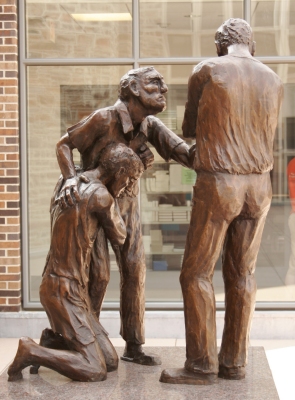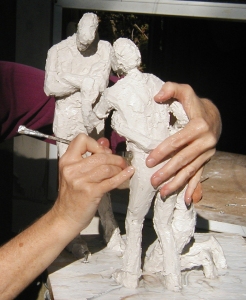| |
| |
 |
| |
Reconciliation
By Margaret Adams Parker |
| |
|
Commissioning the
SculptureIn my
own mind, I have always thought of the Parable of the
Prodigal Son (Luke 15:11-32) as “the great parable.”
Over the years, I have taught the parable to seminary
students; I have discussed it with Bible study groups in
church basements and parish halls; I have explored it
with ordained clergy. Sometimes I have used great art –
often the work of Rembrandt – to help us enter the
narrative. At other times, I have led participants in
the making of their own images of the story. I have also
learned that this parable, perhaps because it is set
within a family, has a way of intersecting with real
lives. It sometimes provokes disagreement, even anger.
But for me it remains one of the most powerful means of
understanding God’s limitless capacity for forgiveness.
I was, therefore,
immensely pleased to receive a commission to create a
sculpture depicting this parable for the Duke Divinity
School’s 2005 addition in Durham, North Carolina. Old
Testament professor Ellen F. Davis had introduced me to
the school’s Dean, theologian L. Gregory Jones. He
selected the subject for the sculpture after discovering
that he and I shared a long-time interest in the
parable. His book, Embodying Forgiveness,
reproduces on the cover Rembrandt’s 1642 drawing of the
reunion of the father with the prodigal. Moreover, Dean
Jones felt that a sculpture on this parable would be
emblematic of the Divinity School’s work on
reconciliation. The 2005 addition to the Duke Divinity
School includes a Center for Reconciliation.
 |
|
| |
|
With the subject chosen,
I began to work with the Arts Committee, an advisory
group comprised of Divinity School faculty,
administrators, staff, and a chaplain. I was the first
artist they worked with, but by the time the addition
was complete the committee had worked I feel strongly
that any commission should be a collaborative effort,
with the artist and the commissioning institution
working together to achieve a result which will be
satisfying to both. We began our work together
accordingly by reading the parable and discussing it.
It is a challenge to
take any extended story – this is the longest of the
biblical parables – and depict it in a single work of
art. Where a filmmaker or choreographer is able to
present the complete narrative, a sculptor can “tell”
only one part of the story. For instance, we might have
chosen to depict the prodigal’s initial demand for his
patrimony, his “coming to himself” among the pigs, or
his journey home. But the committee and I agreed that
while all of these scenes are essential to the tale, the
events at the end – scenes involving prodigal, father,
and older brother – serve best to summarize the meaning
of the whole. Based on our discussions, I proposed to
make five small plaster “sketches” representing
different ways of depicting the parable’s ending.
I
returned with the sketches 6 months later. These offered
variations on the reunion of prodigal and father, with
the older brother included in some of the sketches. In
one sketch, for instance, the older brother viewed the
reunion of father and prodigal from a position on the
far side of a doorway. Interestingly the committee’s
first choice was the sketch, which I had hoped they
would choose and I took this as an indication that the
committee and I were working well together. The sketch
was a response to a comment by Andrew T.P. Merrow, the
rector of my home parish (St. Mary’s in Arlington,
Virginia), that the father was the bridge between the
two brothers: I showed the father embracing the
prodigal, but turning to reach out to the older brother.
This version conflates the two scenes at the end of the
parable, but all of us agreed that it best captured our
understanding of the story. |
|
![]()